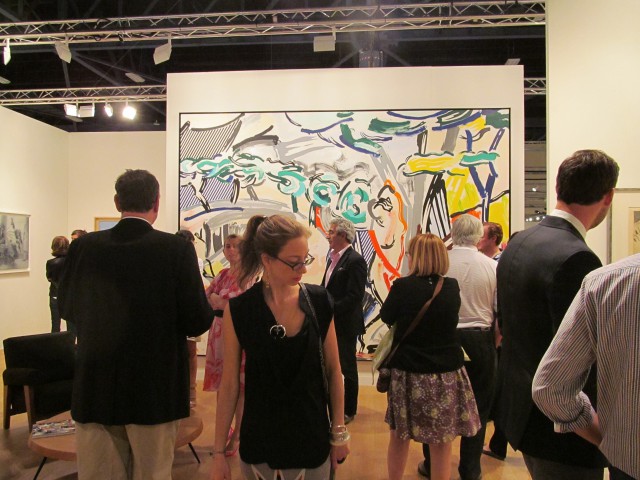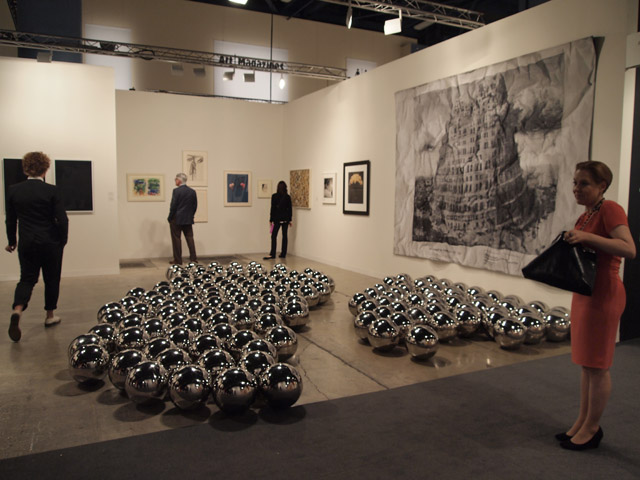Art Basel Miami Beach is not fun, but sometimes, through the fluorescent lighting, puzzle-piece layout, and brazen privilege, you see some art you like. This is not a typical sentiment at an art fair, populated as they are with the type of work only a catnipped cat would love. However, this year we—and a few others—noticed something a little fishy: for an art fair, the work was in surprisingly good taste. Aside from the inevitable neon signage, Erwin Wurms, and shiny anal bead sculptures, overall, we found some reliable standards, surprises, and cohesive, well-curated booths that wouldn’t have seemed out of place in any museum collection.
Gavin Brown has a known eye for booth curation, but he outdid himself this year, splitting the sightline of a red-and-blue carpet painting by Jonathan Horowitz in two with a line of Martin Creed trompe l’oeil cactus sculptures. We can’t imagine either work looking as good alone as they do together here. Add a series of colorful abstract paintings by Laura Owens and Brown’s booth is as close to perfect as they get. Also worth a look is the back room at David Kordansky, which is filled with Aaron Curry’s neon sculptures and wall-mounted work. Curry’s art is a perfect fit for Basel, as it’s basically modernism updated with bright paint.
Mitchell-Innes & Nash gets points for filling their booth with women—like Sarah Braman, Virginia Overton, Keltie Ferris, and Catherine Opie—a move that shouldn’t be daring, but is, since men still remain the go-to at the fairs. Both Braman and Overton’s works play with raw materials and optical japery, but without seeming gimmicky. Braman gets that point across with Our Morning (summer) (2012), a blue and purple translucent cube hovering just above the floor, and Overton’s similarly trompe l’oeil plywood lean-to that, somehow, doesn’t fall to the ground, weighed down as it is with a sandbag. With this booth in mind, we’d like to think it could open a few eyes to the idea that a predominantly female showing isn’t so bad.
This type of playful, assembled sculpture popped up at a fair number of booths: there were Harry Dodge’s broomstick-punching bag-whatever-he-could-find-sculptures at Wallspace; Michael Budny’s faux-paintings covered in semi-transparent plastic sheeting at Galerie Nächst St. Stephan Rosemarie Schwarzwälder; and Arlene Shechet’s ceramic, brick, and steel sculptures at Sikkema Jenkins. We haven’t heard much about Shechet since 2010, when she was still showing singularly blobby sculptures at Jack Shainman. Those shapes don’t seem to be in her vocabulary anymore; now, she’s making airy, lopsided works, full of what look like painted sponges and gooey worms, that somehow appear sturdy.
Pace put on a museum-quality booth that wouldn’t have looked out of place as a collection show surveying postwar and contemporary art. It included a few surprises, like a 2007 Bridget Riley that’s more color field than op, and some unusual pairings of big-name artists—like the Josef Albers, Sol LeWitt, Elizabeth Murray, and Donald Judd corner that riffed on all the artists’ use of geometry. Each work employed squares and the appearance of depth in some way. While every gallery wants to pull out their most tried-and-true artists for the fairs, it’s rare that they look that good together.
Of course, one thing you’ll never run short on at the fairs are museum darlings: anybody with a recent retrospective is certain to have their work available for purchase. We saw more Rosemarie Trockel than usual, thanks to her current retrospective at the New Museum; Alighiero Boetti (Game Plan at MoMA), Roy Lichtenstein (retrospective at the Art Institute of Chicago), and Martin Creed (Tate Liverpool, amongst other shows) also popped up at multiple booths.
Gagosian seems to have a monopoly on all the good Lichtensteins at the fair; we’re not sure what their secret is, other than having buckets of money. Their booth as a whole, though, provides one of the more unpleasant fairgoing experiences, offering one-stop shopping for all your modern and post-war needs. Gagosian brought two of every artist—Richter, Lichtenstein, Picasso, Ruscha, Koons, Prince—to Basel, along with a couple of their ever-present security guards.
Other galleries found more interesting ways to be unappealing. Galerie Perrotin packed their booth with everything shiny (Jean-Michel Othoniel’s hanging anal beads), large (Elmgreen & Dragset’s oversized bust of Gustav Mahler), and gimmicky (Daniel Firman’s brooding preteenager and Takashi Murakami’s portraits). Xavier Hufkens, meanwhile, thought it would be a good idea to bring mostly gold-colored works—possibly appealing to collectors’ love of money? Salon 94 brought a solo showing of dude-bro art by Jon Kessler, who seemed to explode a few trends in recent art (mouthwash, iPads, and broken glass) and attach them to animatronic children and animals.
Other than bad taste, there was some monotony on view with the secondary market. A handful of galleries ended up showing remarkably similar Donald Judd wall-reliefs from the 80s and 90s (should have called each other first). It’s not uncommon for galleries to overlap with artists, but it’s a harder problem to disguise when it’s someone like Judd who specializes in all things metal and boxes. Pace, David Zwirner, and Barbara Mathes Gallery all showcased patchwork-colored Judds, the perfect scale for a horizontal hang in the living room. These works are popular, and unlike many of his earlier ones, they don’t require a ton of space.
Judging the how and why of an art fair is a little like evaluating the causes of a storm from its center; from what we can tell, though, this is a good year for Basel, and it’s at least not so much of a bore. This average booth this year brought a combination of smart works mixed in with a few flops, and it seemed like galleries weren’t in such a mad rush to lure collectors in with bright, reflective, tacky things. Good news for art; bad news for art collecting raccoons.








{ 1 comment }
Im sorry but can we face it. Art fairs are just depressing. Everything seems so trite in cubicles bellow a high looming ceiling. Its like we try to turn off all the things we learn about presentation that we use to asses the works when judging the entire event.
Comments on this entry are closed.